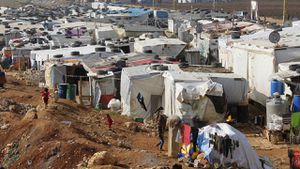Amid an era defined by climate extremes, scientists have sounded an alarming clarion call: levels of atmospheric carbon dioxide (CO2), the most significant greenhouse gas contributing to global warming, are rising faster than ever before. This surge to new record highs, beyond anything humans have historically experienced, underscores an urgent need for action.
Researchers from the National Oceanic and Atmospheric Administration (NOAA) and the Scripps Institution of Oceanography at the University of California San Diego disclosed that the measurements taken at the Mauna Loa Atmospheric Baseline Observatory have revealed an unprecedented spike. In May 2024, CO2 levels peaked at just under 427 parts per million (ppm), indicating an increase of 2.9 ppm from May 2023. This figure marks the fifth-largest annual growth in NOAA's 50-year record and the largest two-year jump in CO2 levels ever documented.
“Over the past year, we’ve experienced the hottest year on record, the hottest ocean temperatures on record, and a seemingly endless string of heat waves, droughts, floods, wildfires, and storms,” commented NOAA Administrator Rick Spinrad. “Now we are finding that atmospheric CO2 levels are increasing faster than ever. We must recognize these as clear signals of the damage carbon dioxide pollution is doing to the climate system and take rapid action to reduce fossil fuel use as quickly as we can.”
The findings are gravely concerning. Despite international reports indicating a plateau in fossil fuel emissions, atmospheric CO2 concentrations continue to rise sharply. The so-called Keeling Curve, maintained by Scripps, captured this distressing trend when it documented a May average of 426.7 ppm for 2024, an increase similarly large to that documented by NOAA. For Ralph Keeling, director of the Scripps CO2 program, these measurements reflect a troubling acceleration in the climate crisis. “Not only is CO2 now at the highest level in millions of years, it is also rising faster than ever,” he stated.
The Science of CO2 Accumulation
Carbon dioxide, while naturally occurring, has been exponentially amplified by human activities, primarily through the burning of fossil fuels such as coal, oil, and natural gas. This gas acts much like a blanket, trapping heat from the sun and preventing it from escaping back into space, thereby warming the Earth’s atmosphere. This process intensifies the greenhouse effect, leading to a cascade of environmental impacts.
The Mauna Loa Observatory in Hawaii provides a critical baseline for understanding long-term CO2 trends. Measurements at this facility reveal seasonal fluctuations—CO2 levels rise during the fall and winter months when plant growth is minimal and drop during the spring and summer due to photosynthetic activity. However, the overall trend has been a relentless climb in CO2 concentrations, a pattern first identified by Charles David Keeling in 1958. His work led to the development of the Keeling Curve, a record that has become a fundamental indicator of climate health.
Why the Surge?
The enormous leap in CO2 levels from 2022 to 2024 is attributed to both continued high fossil fuel emissions and the influence of El Niño conditions. During El Niño phases, warmer ocean temperatures can reduce the capacity of land and ocean systems to absorb CO2, leading to higher atmospheric concentrations. The result is a more potent greenhouse effect, exacerbating climate change phenomena.
John Miller, a carbon cycle scientist with NOAA’s Global Monitoring Laboratory, notes that this double-whammy effect of sustained emissions and natural climate variability sharpens the effects on global carbon cycles. One significant consequence is ocean acidification, a direct result of dissolved CO2 altering seawater chemistry. This process can impair marine life, particularly organisms that rely on calcium carbonate structures, such as coral reefs and certain shellfish.
Visible Impacts
The surge in CO2 levels has profound ecological and societal impacts. Rising temperatures contribute to the frequency and intensity of extreme weather events. Heatwaves become hotter and longer, droughts more severe, and precipitation patterns more erratic. The past year alone saw unprecedented natural disasters, inflicting economic damage and costing lives.
NOAA highlights that the consequences of these rising CO2 levels go beyond immediate weather patterns. Long-term, sustained increases in greenhouse gases pose existential risks to ecosystems and biodiversity. For example, the absorption of CO2 by the oceans not only triggers acidification but also depletes oxygen levels, creating “dead zones” where aquatic life struggles to survive.
The intergovernmental push for climate action has seen some progress in recent years, with many countries pledging to reduce emissions and transition to renewable energy sources. Yet, the data from Mauna Loa underscores a critical urgency—current efforts may be insufficient to curb the rapid ascent of CO2 levels.
Complex Processes and Future Directions
Understanding and mitigating the rise in CO2 involves tackling complex biogeochemical cycles. The carbon cycle is a natural process wherein carbon is exchanged between the atmosphere, ocean, and terrestrial ecosystems. Human activities have disrupted this balance, leading to the current crisis.
Efforts to mitigate CO2 emissions focus on multiple fronts. Policy measures include carbon pricing, which incentivizes lower emissions, and investment in green technologies, such as solar and wind power. Additionally, restoring forests and other natural carbon sinks can enhance the planet’s ability to absorb atmospheric carbon.
Nevertheless, scientists caution that even if emissions were substantially reduced, the legacy of past emissions would continue to influence climate patterns for decades. The lag in the system means that efforts made today will primarily benefit future generations, a challenging message for policymakers and the public alike.
Addressing the climate crisis effectively requires a multidisciplinary approach, integrating environmental science, economics, and social policy. It demands a concerted global effort with commitments at international, national, and local levels to effect substantive change.
Challenges and Mitigation Strategies
Several challenges complicate climate change mitigation. Economic dependencies on fossil fuels, geopolitical interests, and social resistance to change all play roles in hindering progress. Additionally, the uneven distribution of climate impacts means that developing nations, which are often least responsible for emissions, suffer disproportionately from climate change repercussions.
Mitigation strategies must therefore be both equitable and effective. International frameworks such as the Paris Agreement aim to foster cooperation and set binding targets for emission reductions. Financial mechanisms, such as the Green Climate Fund, provide resources to help developing countries adapt and build resilient infrastructures.
Moving Forward
Looking ahead, the path to stabilizing CO2 levels involves both immediate actions and long-term commitments. Researchers emphasize the need for continued monitoring and data collection to inform policy decisions and track progress. Expanding renewable energy infrastructure, enhancing energy efficiency, and adopting sustainable practices in agriculture and industry are critical steps.
Future research will focus on refining climate models to better predict outcomes and identify the most effective interventions. Innovative technologies, such as carbon capture and storage (CCS), offer potential solutions for reducing atmospheric CO2. However, these technologies are still under development and require substantial investment and policy support.
Ultimately, addressing the rapid rise in CO2 and mitigating its effects is a global challenge that calls for unprecedented cooperation and innovation. The data from Mauna Loa is a stark reminder of the stakes involved and the urgency required to protect our planet for future generations.



